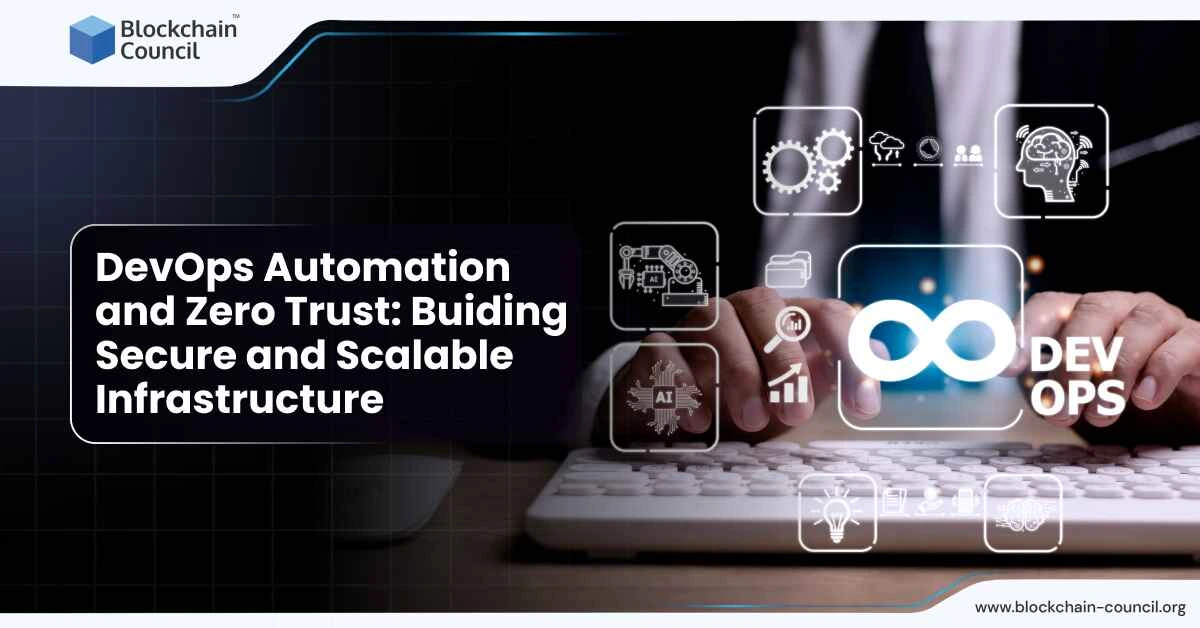
- Blockchain Council
- October 29, 2024
DevOps Automation and Zero Trust: Building Secure and Scalable Infrastructure
Building secure and scalable infrastructure is critical for businesses that want to keep up with evolving technology demands. DevOps automation simplifies operations and boosts productivity, while Zero Trust architecture ensures security is deeply integrated at every stage. This article explores how combining DevOps automation with Zero Trust principles helps create infrastructure that’s both secure and scalable, without compromising agility.
Understanding DevOps Automation
Before diving into Zero Trust, it’s essential to first understand how DevOps automation fits into the picture. DevOps automation refers to the use of tools and processes to automate repetitive tasks in software development, deployment, and operations. It significantly reduces manual intervention, enhancing consistency and speeding up processes across the pipeline.
By automating tasks like testing, monitoring, and infrastructure provisioning, teams can focus more on innovation rather than tedious, error-prone activities. DevOps automation platforms offer businesses the ability to smoothly integrate these tasks, creating a strong and efficient workflow. However, to truly protect these automated processes, an equally powerful security framework is necessary, and that’s where Zero Trust comes into play.
Principles of Zero Trust
At its core, Zero Trust is about eliminating the assumption that any user, device, or system inside the network should be automatically trusted. Instead, it advocates for continuous verification of every action, guaranteeing that every request made within the system is authenticated and authorized.
Let’s break down the key principles of Zero Trust:
Verification and Authentication
Zero Trust requires constant verification and authentication of both users and devices. Unlike traditional security models that trust entities within the network, Zero Trust continuously checks every interaction to make sure it’s legitimate. This is essential when automating workflows, as it ensures that only approved tools and users can execute processes within the DevOps pipeline.
Least Privilege Access
Another core principle of Zero Trust is the concept of least privilege access. This means granting users or services only the minimal level of access necessary to perform their tasks. In a DevOps environment, this principle prevents unauthorized modifications or access to critical systems, reducing the attack surface significantly.
Micro-Segmentation
Micro-segmentation involves breaking down the network into smaller, isolated segments. By implementing micro-segmentation, DevOps teams can limit the damage caused by any potential breaches. In the context of automation, it ensures that even if one part of the system is compromised, the attacker cannot move laterally through the entire network.
Continuous Monitoring
Zero Trust doesn’t stop at initial verification—it requires continuous monitoring of all activities to detect any anomalies. In an automated DevOps pipeline, continuous monitoring helps to identify suspicious behavior early and trigger automated responses, maintaining the integrity of the infrastructure.
Integrating DevOps Automation with Zero Trust
When combining DevOps automation with Zero Trust, the focus should be on creating a security-first culture that smoothly operates alongside automation. Here’s how these two models can work together:
Automating Security Policies
Automation makes it possible to implement security policies consistently across all environments. By integrating Zero Trust principles with automation, security checks can be automatically enforced at every stage of the DevOps pipeline. This ensures that no code, environment, or user bypasses critical security validations.
Infrastructure as Code (IaC) and Zero Trust
Infrastructure as Code (IaC) enables teams to manage and provision computing infrastructure through machine-readable scripts. When Zero Trust is layered onto IaC, it ensures that security policies are enforced throughout the automated provisioning process. Every piece of infrastructure, whether it’s a virtual machine or container, is created with security in mind, following Zero Trust protocols from the start.
Automated Compliance and Auditing
One of the often-overlooked benefits of combining automation and Zero Trust is the ability to automate compliance and auditing tasks. Security controls can be monitored continuously, and any violations can be flagged or addressed in real-time. This automated approach not only strengthens security but also simplifies compliance management.
Implementing Zero Trust in a DevOps Environment
Building a Zero Trust environment within a DevOps framework requires careful planning and execution. Here’s how to implement these practices effectively:
Securing CI/CD Pipelines
Your CI/CD pipelines are at the heart of the DevOps process, so securing them is crucial. Implementing Zero Trust principles, such as multi-factor authentication and strict access control, guarantees that only authorized tools and individuals can interact with the pipeline. This minimizes the risk of unauthorized code being introduced into the environment.
Integrating Identity and Access Management (IAM)
Identity and Access Management (IAM) tools can play a critical role in implementing Zero Trust. By automating IAM policies, you can control who has access to different parts of your infrastructure, enforcing least privilege access. This ensures that every user and service is continuously verified and authenticated, reducing the risk of insider threats.
Continuous Security Monitoring and Response
In a Zero Trust environment, real-time monitoring is absolutely essential. By integrating security monitoring tools with your DevOps workflows, you can automatically detect and respond to potential threats. Whether it’s an unusual login attempt or a sudden spike in resource usage, continuous monitoring keeps your infrastructure secure while your automation tools keep your operations running smoothly.
Challenges and Considerations
Although the integration of DevOps automation and Zero Trust offers significant benefits, it’s not without challenges. Understanding these challenges can help ensure a smoother transition to a secure, automated infrastructure.
Firstly, implementing Zero Trust across a complex DevOps pipeline may require significant changes to existing processes. This could involve redesigning workflows or integrating new tools, which may cause friction initially. Another consideration is the balance between security and productivity. Too many security checks might slow down processes, so it’s important to find the right balance between protecting your infrastructure and keeping operations efficient.
Additionally, the tools and technologies used for Zero Trust and automation must work together smoothly. Ensuring compatibility between security and automation tools can prevent unnecessary delays or inefficiencies in your DevOps process.
In conclusion, combining DevOps automation with Zero Trust security is a powerful approach to building secure, scalable infrastructures. By automating workflows while embedding strict security protocols, businesses can not only protect their operations but also enhance efficiency and speed.
As the demand for secure, reliable infrastructure grows, integrating these two models is no longer optional—it’s essential. Whether you’re automating security policies or continuously monitoring your pipeline, this approach helps you stay ahead of threats while maintaining the scalability needed for modern business growth.




































































 Guides
Guides News
News Blockchain
Blockchain Cryptocurrency
& Digital Assets
Cryptocurrency
& Digital Assets Web3
Web3 Metaverse & NFTs
Metaverse & NFTs
